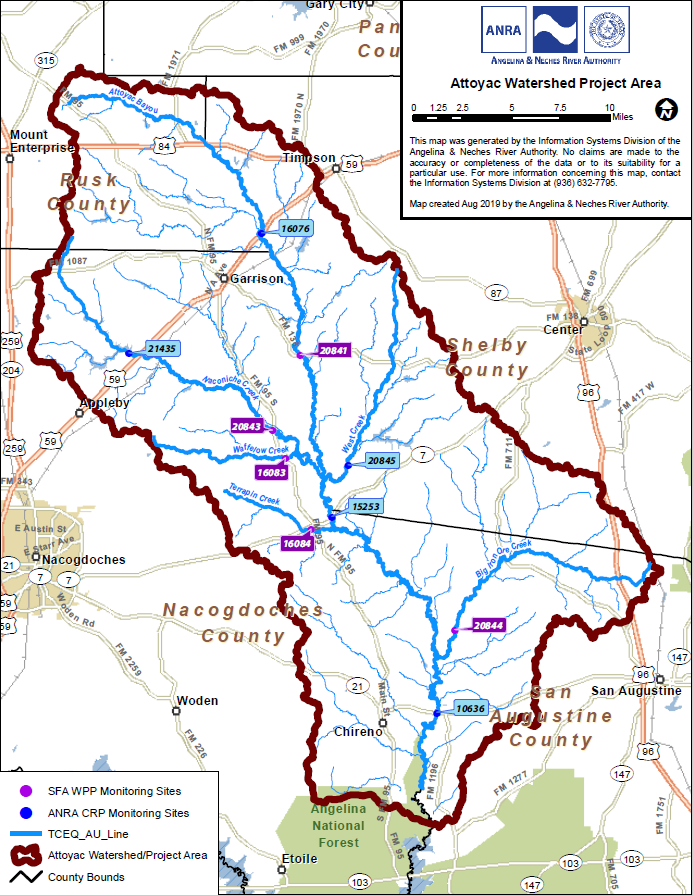East Texas stakeholders and a team of university researchers and agency staff are working to improve water quality in the region’s many watersheds and are already seeing positive results in one watershed and making substantial progress in another, according to Texas Water Resources Institute (TWRI) staff.
For the last 10 years, a team of Angelina & Neches River Authority (ANRA) staff and Stephen F. Austin State University (SFA) and TWRI researchers have monitored and evaluated water quality in several East Texas watersheds.
This water quality information is relayed to local stakeholders who can use it to develop watershed-based plans to improve and maintain the health and integrity of these water bodies.
The Attoyac Bayou was the first water body evaluated by this team, and the bayou has recently seen part of its water quality improve. The bayou flows through portions of Rusk, Shelby, Nacogdoches and San Augustine counties before emptying into San Rayburn Reservoir.
In 2004 the Texas Commission on Environmental Quality (TCEQ) listed the bayou as impaired on the Texas Integrated Report of Surface Water Quality for the Clean Water Act Sections 305(b) and 303(d) due to high levels of E. coli bacteria.
The Attoyac Bayou Watershed Partnership organized in 2009 to address this issue. The partnership consists of local agricultural producers, city and county government staff, landowners and others interested in protecting the bayou. Funding support was provided by the Texas State Soil and Water Conservation Board through a Clean Water Act, Section 319(h) grant from the U.S. Environmental Protection Agency.
Through a series of partnership meetings, the stakeholders developed watershed management strategies recommended to reduce bacteria levels in the bayou with the goal of meeting the state’s water quality standards. The Attoyac Bayou Watershed Protection Plan was completed in 2014 and accepted by EPA in 2015.
Dr. Lucas Gregory, TWRI senior research scientist, explained that every two years, TCEQ evaluates water quality across Texas. In its most recent assessment, TCEQ is delisting the lower third of the water body because it meets its designated water quality standards; however, the upper two-thirds remain impaired.
“Management strategies included in the watershed plan are being implemented, and local water quality is starting to improve. Now part of the bayou is no longer considered impaired,” Gregory said.
Dr. Matthew McBroom, SFA’s associate dean and professor in the Arthur Temple College of Forestry and Agriculture, said the successful delisting can be credited to the work of the Attoyac Bayou Watershed Partnership and the research team.
“With implementation activities including agricultural land management and septic system repairs and replacements underway, water quality is beginning to improve,” McBroom said. “Water quality monitoring by ANRA and SFA is showing these improvements.”
Now TWRI, ANRA, SFA and local stakeholders are working in other East Texas watersheds, including the Angelina River above Sam Rayburn Reservoir, La Nana Bayou, the Lower Neches River and tributaries of the Middle and Lower Neches River. Tributaries of the Middle Neches include Jack, Cedar, Hurricane and Biloxi creeks, while those of the Lower Neches include Sandy and Wolf creeks.
Anna Gitter, TWRI research associate, said the predominant water quality impairment in these other East Texas watersheds, as in the Attoyac Bayou, is bacteria.
“The state uses E. coli to monitor water quality in freshwater and indicate the potential presence of fecal pollution in a water body,” Gitter said. “Although E. coli is a naturally occurring bacteria found in the gastrointestinal system of all warm-blooded animals, high concentrations of this bacteria may indicate that a water body may be contaminated with fecal pathogens and pose a potential risk for human health.”
Gitter said other water quality concerns in East Texas waters include low concentrations of dissolved oxygen, which is critical for aquatic life, and high concentrations of nutrients, which can negatively impact dissolved oxygen as well.
Michael Schramm, TWRI research associate, said these water bodies are being studied and monitored to identify potential pollution sources of bacteria and develop a better understanding of each individual watershed.
“Data gathered from monitoring efforts includes flow measurements, water temperature, specific conductivity and concentrations of bacteria, dissolved oxygen and nutrients,” Schramm said. “These parameters are used to provide check-ups of current water quality. This information ultimately helps stakeholders determine best management practices for improving each watershed’s water quality.”
Gregory said the project team discusses the collected data with local stakeholders to determine which management practices will be most appropriate for the specific watershed.
“Monitoring, evaluation and input from local experts increase our understanding of these watersheds,” he said.
TWRI, ANRA and SFA continue to work on implementing and managing the Attoyac Bayou Watershed Protection Plan.
“We continue to monitor water quality and to measure interim progress of the plan’s implementation to ensure this restoration effort remains a success,” Gregory said.
Dr. John Tracy, TWRI director, said restoring and protecting the state’s water resources is a critical part of TWRI’s the work.
“The success of the Attoyac Bayou and the work we are doing now in the rest of East Texas says a lot about the support of the residents and agencies involved in this area and their understanding of the importance of their water resources,” he said.
For more information or questions about projects in the East Texas area, contact Gregory, 979-845-7869, lfgregory@ag.tamu.edu, Jeremiah Poling, 936-632-7795, jpoling@anra.org, or McBroom, 936-468-3301, mcbroommatth@sfasu.edu.





